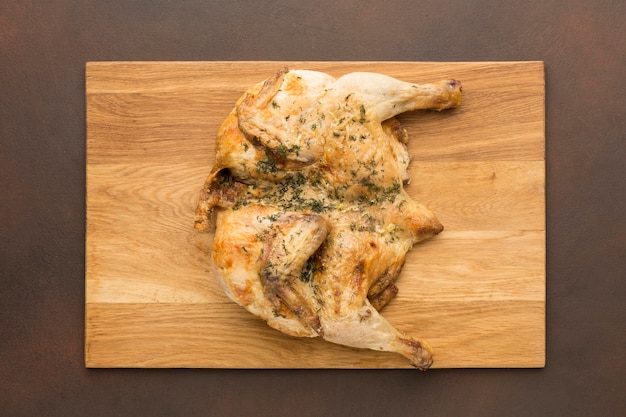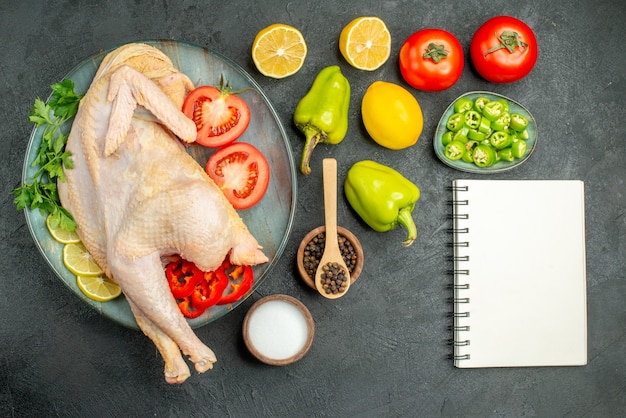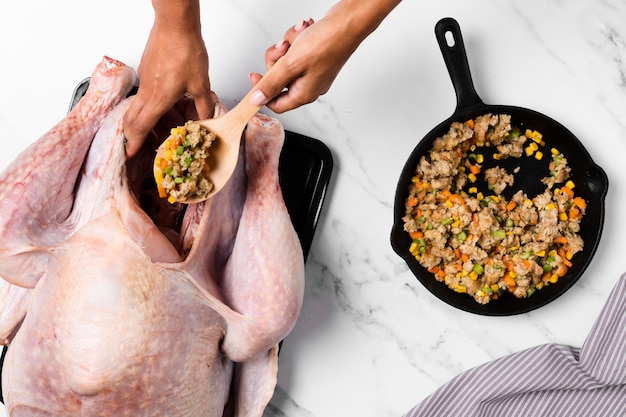I've been cooking for as long as I can remember. My Mum, bless her soul, taught me everything from whipping up a simple custard to tackling a roast chicken. But even with years of experience, I'll admit, there's one thing that still gives me the jitters: chicken. I'm not talking about the clucking kind, mind you, but the cooked kind. You see, I've always been a bit paranoid about food safety, especially when it comes to poultry. The thought of accidentally serving undercooked chicken sends shivers down my spine. After all, we've all heard the horror stories about salmonella poisoning.
So, over the years, I've become quite the chicken cooking fanatic. I've read countless articles, watched countless videos, and even consulted with a few chefs about the best way to ensure that my chicken is cooked to perfection, without risking anyone's health. But what I've discovered is that the information out there can be quite confusing and contradictory. Some say 165 degrees Fahrenheit, others say 175 degrees, and then there are the whispers of different temperatures for different parts of the chicken. It's enough to make your head spin, isn't it?
So, I thought, why not share everything I've learned about safe internal temperatures for cooking chicken? It might just save you from a few sleepless nights and a whole lot of worry. Plus, you can be sure you're serving up a delicious, perfectly cooked meal every time. Let's dive in!
(Part 1) The Basics: Why Temperature Matters

Before we delve into the specifics of chicken cooking, let's first understand the importance of temperature in food safety. It all boils down to the little critters that love to hang out in raw chicken: bacteria. These tiny organisms, like salmonella and campylobacter, can cause foodborne illnesses if not properly eliminated.
Understanding the Danger Zone
Think of the danger zone as a playground for bacteria. It's the temperature range between 40°F (4°C) and 140°F (60°C), where these nasty little buggers can multiply rapidly. This means that if you leave raw chicken out at room temperature for too long, those bacteria will have a party, and you won't like the results.
Why Internal Temperature is Key
The only way to be absolutely sure those bacteria are eliminated is by cooking the chicken to a safe internal temperature. This is where a meat thermometer becomes your culinary hero. It allows you to accurately measure the chicken's internal temperature, ensuring it's reached a point where harmful bacteria have been destroyed.
The Importance of Consistent Cooking
Cooking chicken is like baking a cake. You need to bake it for the right amount of time at the right temperature to ensure it's cooked through. It's all about finding that sweet spot between "raw" and "overcooked." Simply relying on appearance is not enough, and that's where the thermometer comes in handy. It's like having a little helper in the kitchen, assuring you that you're on the right track.
(Part 2) The Official Recommendations: What the Experts Say

When it comes to food safety, the U.S. Department of Agriculture (USDA) is the gold standard. They are the official experts on food safety, and their recommendations are designed to protect public health.
The U.S. Department of Agriculture (USDA) Guidelines
The USDA recommends that chicken should be cooked to an internal temperature of 165°F (74°C) for at least 15 seconds. This temperature is enough to kill off any potentially harmful bacteria. Remember, it's always better to err on the side of caution when it comes to food safety.
Other Recommendations
You might hear some folks say that 165°F is a bit too high, and that you can safely cook chicken to an internal temperature of 160°F (71°C). While this may be true in some cases, the USDA guidelines are based on extensive scientific research and are designed to be universally safe. I personally stick to their guidelines, as I believe it's better to be safe than sorry.
The Importance of Accuracy
Choosing a reliable thermometer is crucial. There are many different types available, from traditional analog thermometers to fancy digital ones. The key is to choose a thermometer that's accurate and reliable. You wouldn't want to be misled by a faulty thermometer, would you?
(Part 3) The Different Parts of the Chicken: Temperature Specifics

Now that we've covered the basics, let's dive into the specifics of cooking different parts of the chicken. The USDA guidelines recommend a minimum internal temperature of 165°F (74°C) for all parts of the chicken. However, some parts, like breasts and thighs, might require slightly different approaches.
Breast
chicken breasts are notoriously tricky. They can easily become dry and tough if you cook them too long. The key to perfectly cooked chicken breasts is achieving that delicate balance between cooked through and juicy. You want to ensure the internal temperature reaches 165°F without overcooking the breast. If you're cooking chicken breasts in the oven, keep a close eye on the thermometer and consider using a lower temperature for a longer time. For grilling, flip the breasts halfway through to ensure even cooking.
Thigh
chicken thighs are more forgiving than breasts and tend to hold onto their moisture better. They can be cooked to a slightly lower temperature, around 160°F (71°C). But remember, this is just a general guideline. The best way to determine whether your chicken thigh is cooked through is by using a thermometer. Stick it into the thickest part of the thigh, and make sure it reaches that magic 160°F. And remember, don't forget to check the internal temperature in the thickest part of the thigh. You want to make sure that the whole thing is cooked through.
Wings
chicken wings are a bit of a wild card. They're small and can be cooked relatively quickly, so you don't need to worry about them taking forever. The USDA recommends a temperature of 165°F (74°C) for chicken wings. This is particularly important for wings that are being deep-fried. The key with chicken wings is to ensure that they're cooked evenly. You want that crispy skin and juicy meat throughout. If you're grilling chicken wings, be sure to flip them often to ensure even cooking. And if you're deep-frying them, make sure the oil is hot enough to cook them through quickly and evenly.
Drumsticks
chicken drumsticks are another favourite of mine. They're super versatile and can be grilled, roasted, or fried. And just like with thighs, they're more forgiving than breasts when it comes to cooking time. The USDA recommends an internal temperature of 165°F (74°C) for drumsticks. If you're grilling chicken drumsticks, be sure to use indirect heat and rotate them every 15 minutes to ensure even cooking. If you're roasting them, make sure they're placed in a single layer in the oven and that there's plenty of space between them to allow for air circulation. And if you're frying them, be sure to use a thermometer to make sure the oil is hot enough and that the drumsticks are cooked through.
(Part 4) Common Myths: Debunking the Misinformation
You've probably heard some myths about cooking chicken that might leave you confused. Let's debunk some of these common misconceptions.
The "No Pink" Myth
One common myth is that chicken should be cooked until it's no longer pink. While it's true that pinkness can be an indicator of undercooked chicken, it's not always reliable. Chicken can sometimes appear white, even if it's not fully cooked. So, don't rely on colour alone to judge the doneness of your chicken. Always use a thermometer to confirm that the internal temperature has reached the recommended 165°F. Remember, safety comes first.
The "Resting" Myth
Another common myth is that chicken should be rested for 10 minutes after cooking. The idea is that resting allows the juices to redistribute throughout the meat, making it more tender. While this is true for some types of meat, it's not really necessary for chicken. In fact, resting chicken for too long can actually increase the risk of bacteria growth. So, if you're concerned about food safety, it's best to serve your chicken immediately after it's cooked. If you absolutely must rest it, do it for a maximum of 5 minutes.
(Part 5) Cooking Methods: How Temperature Plays a Role
Now, let's explore some common cooking methods and how temperature plays a vital role in ensuring safe and delicious results.
oven roasting
Oven roasting is a classic way to cook chicken. It's simple, versatile, and allows for even cooking. When roasting chicken, be sure to use a meat thermometer to check the internal temperature in the thickest part of the breast or thigh. Aim for a temperature of 165°F (74°C) for the breast and 160°F (71°C) for the thigh. Once the chicken has reached the desired temperature, remove it from the oven and let it rest for 5 minutes before carving.
Grilling
Grilling chicken is a great way to add a smoky flavour. When grilling, be sure to use indirect heat. This means cooking the chicken over the cooler part of the grill, not directly over the flames. If you're using a gas grill, turn off the burner closest to the chicken. If you're using a charcoal grill, move the coals to one side of the grill. Place the chicken over the cooler side and close the lid. Use a thermometer to check the internal temperature, aiming for 165°F (74°C) for the breast and 160°F (71°C) for the thigh.
Pan-Frying
Pan-frying is a great way to cook chicken quickly and easily. When pan-frying, be sure to use a heavy-bottomed pan and heat it over medium-high heat. You want the pan to be hot enough to sear the chicken but not so hot that it burns. Place the chicken in the pan and cook for 3-4 minutes per side, or until golden brown and cooked through. Use a thermometer to check the internal temperature, aiming for 165°F (74°C) for the breast and 160°F (71°C) for the thigh.
Deep-Frying
Deep-frying is a great way to cook chicken for a crispy, golden-brown exterior. When deep-frying, be sure to use a thermometer to make sure the oil is hot enough. The ideal temperature for deep-frying chicken is 350°F (177°C). Place the chicken in the hot oil and cook for 5-7 minutes, or until golden brown and cooked through. Use a thermometer to check the internal temperature, aiming for 165°F (74°C) for the breast and 160°F (71°C) for the thigh.
(Part 6) The Importance of Safe Handling: Beyond the Thermometer
It's not just about cooking temperature; safe handling of chicken is equally crucial to prevent foodborne illnesses.
Proper Storage and Thawing
Always store raw chicken in the coldest part of your fridge, below 40°F (4°C). When you're ready to cook it, make sure you thaw it safely. The safest way is in the fridge, where it can take a few days to thaw. Never thaw it at room temperature, as this can create an ideal breeding ground for bacteria.
Cross-Contamination: The Big No-No
Keep raw chicken separate from other foods to avoid cross-contamination. Use different cutting boards, plates, and utensils for raw chicken and cooked foods. And if you're using a microwave to defrost chicken, be sure to cook it immediately after defrosting.
Wash Your Hands: It's That Simple
Always wash your hands thoroughly with soap and warm water for at least 20 seconds after handling raw chicken. This simple step is essential in preventing the spread of bacteria.
(Part 7) Beyond Chicken: Other Safe Temperatures
While chicken is a common culprit in foodborne illnesses, it's important to be aware of safe cooking temperatures for other types of meat and poultry.
Beef
For beef, the USDA recommends a minimum internal temperature of 145°F (63°C) for ground beef and 145°F (63°C) for steaks, roasts, and chops. For a rare steak, the internal temperature should be between 125°F (52°C) and 130°F (54°C). For medium-rare, it should be between 130°F (54°C) and 135°F (57°C). For medium, it should be between 135°F (57°C) and 140°F (60°C). For medium-well, it should be between 140°F (60°C) and 145°F (63°C). For well-done, it should be 145°F (63°C) or higher.
Pork
For pork, the USDA recommends a minimum internal temperature of 145°F (63°C). This applies to all cuts of pork, including roasts, chops, and tenderloins.
Fish
For fish, the USDA recommends a minimum internal temperature of 145°F (63°C). This applies to all types of fish, including fillets, steaks, and whole fish.
(Part 8) FAQs: Your Questions Answered
Here are some common questions about cooking chicken and the safe internal temperatures for other meats.
1. Can I Use a Meat Thermometer More Than Once?
It's not recommended to use a meat thermometer more than once without sanitizing it properly. You can easily cross-contaminate between different foods if you're not careful. The best way to sanitize your meat thermometer is by wiping it down with a clean cloth and hot, soapy water. If you're feeling extra cautious, you can even soak the thermometer in a solution of 1 tablespoon bleach per gallon of water for a few minutes.
2. What if I Accidentally Overcook My Chicken?
Don't panic! If you happen to overcook your chicken, it's not the end of the world. The chicken will be safe to eat, but it might be a bit dry. However, there are ways to fix overcooked chicken. For example, you can add it to a soup or stew where the extra moisture will help to tenderize it.
3. Can I Freeze Cooked Chicken?
Yes, you can freeze cooked chicken for up to 2 months. Be sure to wrap it tightly in plastic wrap or aluminum foil to prevent freezer burn. When you're ready to use the frozen chicken, defrost it in the refrigerator overnight.
4. Can I Cook My Chicken to a Lower Temperature If I'm Serving It to Elderly People or Young Children?
It's not recommended to cook chicken to a lower temperature for anyone, especially those with compromised immune systems. The USDA guidelines are designed to ensure that chicken is cooked to a safe temperature, regardless of age.
5. Can I Eat Chicken That Has Been Sitting Out at Room Temperature for a While?
No! It's never safe to eat chicken that has been sitting out at room temperature for more than two hours. Bacteria can multiply rapidly at room temperature, so it's best to err on the side of caution and discard any chicken that has been out for too long.
(Part 9) A Final Thought: Confidence in the Kitchen
So, there you have it! The secrets to safe and delicious chicken cooking. It's not as daunting as it seems, is it? With a bit of knowledge and a good food thermometer, you can be confident that you're serving up a safe and delicious meal for yourself and your loved ones. And trust me, the feeling of accomplishment when you nail that perfect roast chicken is truly satisfying. So, go forth, brave cooks, and conquer the chicken!
Everyone is watching

Prime Rib Roast Cooking Time Chart: Per Pound Guide
Cooking TipsPrime rib roast. Just the name conjures images of lavish dinners, crackling fires, and hearty laughter. It’s ...

How Long to Bake Potatoes in the Oven (Perfect Every Time)
Cooking TipsBaked potatoes are a staple in my kitchen. They're incredibly versatile, delicious, and surprisingly easy to m...

Perfect Rice Every Time: The Ultimate Guide to Cooking Rice
Cooking TipsAs a self-proclaimed foodie, I've always been a bit obsessed with rice. It's the foundation of countless cuisi...

The Ultimate Guide to Cooking Asparagus: Tips, Techniques, and Recipes
Cooking TipsAsparagus. The mere mention of this spring delicacy conjures up images of vibrant green spears, crisp and burs...

Ultimate Guide to Cooking the Perfect Thanksgiving Turkey
Cooking TipsThanksgiving. Just the word conjures up images of overflowing tables laden with delicious food, the scent of r...
